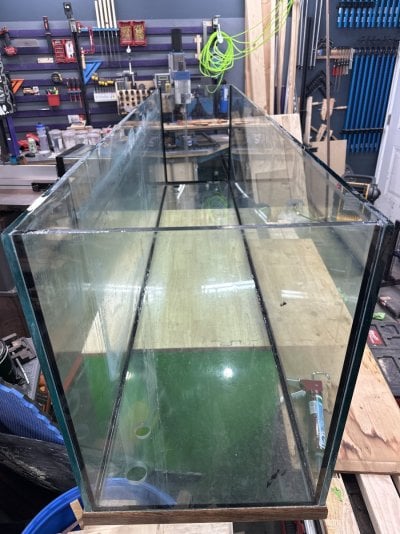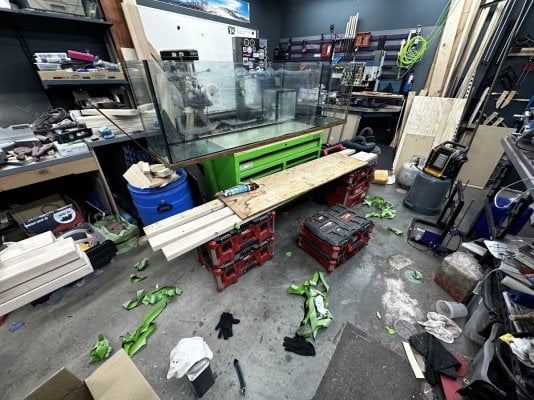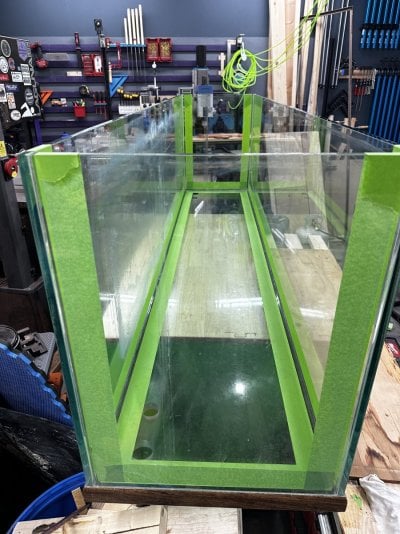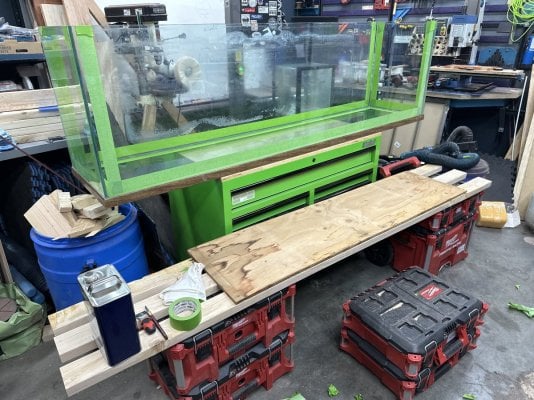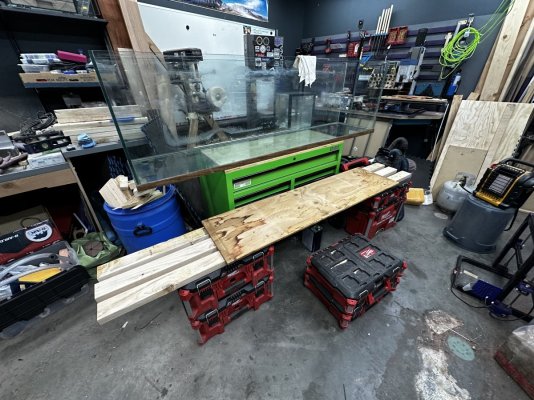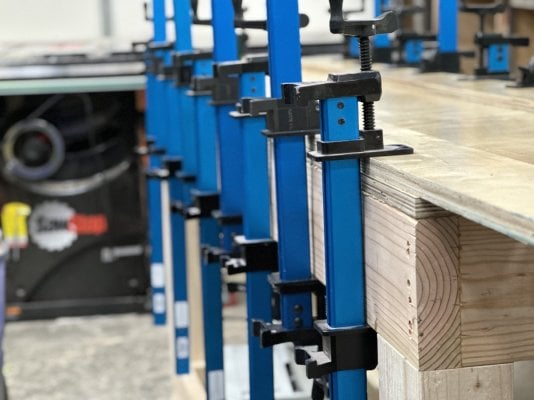I picked up a used Oceanic 160 gallon tank my LFS wasn't using anymore for pretty cheap ($200). Its 84" x 18" x 24" with 1/2" thick glass on the sides, and 3/4" thick on the bottom. It came with a pair of corner overflows and a black acrylic panel that was attached to the glass between the overflows.

The tank has turned into quite the restoration project. The silicone between the glass panels looked like it was it really good shape, but the bead inside the tank was looked pretty worn and thin in spots. Water had found its way behind the black acrylic panel, and left a lot of salt and green gunk behind. Didn't realize how bad that was until after I had agreed to buy it, and we were in the middle of moving it.

After a lot of work, I was able to remove the black panel from the tank, and clean out all of the gunk that had built up behind it. Not sure if it came from the factory with that panel installed or not, but it appears to have been siliconed in place at the same time as the corner overflows were installed, as there was no seam left on the edge of the overflows after I got the panel out. One of the corner overflows also had some broken teeth on it, so I ended up just removing both of them. Still trying to decide what to replace them with.
The back glass panel is in pretty rough shape right now. It has some noticeable etching in it, especially right next to where the silicone was that held the acrylic panel in place. I've tried vinegar and bar keepers friend to try to clean the glass as best I can, but it still looks like it has a lot of whitish / grey build up on it. I was originally planning on painting the back of the glass black, but I'm concerned about how noticeable the etching / buildup will be. I'm considering getting a new acrylic panel cut to put in like it was originally, to hide the glass itself.

The tank is drilled with holes for a 1" and 3/4" line in each corner. I keep going back and forth on just plugging those holes, and drilling the back of the tank for an external overflow, or to just reuse those holes for an internal overflow. This might be a crazy / stupid idea, but if I am already going to put a big acrylic panel back in to cover the back wall of the tank, I could build new corner overflows that are connected together with that back panel, to create an internal coast to coast style overflow. It would be similar to how the overflows work on the Innovative Marine INT tanks, but with the pipes in the corners instead of the middle. Does this seem like a good or bad idea?
Over the weekend, I just finished removing all of the remaining silicone inside the tank to reseal it. The seams themselves still look like they are in really great shape. I also took the time to carefully remove the top trim from the tank to reseal it.
After I got the trim off, I was able to see the seams on the massive center brace in the tank for the first time. They did not look very good. The brace is 23" wide x 1/2" thick, and takes up a lot of space. I can see lots of air gaps in the silicone across the entire length of the brace on one side, and the other side has a 5" section that also has some air gaps in it. I'm definitely concerned that the brace is on its way towards coming loose. I could cut the seams on it, clean it really well, and then reinstall it with some fresh silicone. Also wondering if it might be nicer to replace the single brace with a pair of braces instead.

The trim also appears to be made from 4 separate pieces that were glued together (Looks like fake wood on the outside). Don't really see how this trim is providing much of any support at all. Given that all of the glass walls are 1/2" thick to begin with, would it be a crazy idea to just leave the trim off to convert it to be a rimless tank instead? Or maybe euro-braced?

I'd really appreciate any advice / feedback on this project.
The tank has turned into quite the restoration project. The silicone between the glass panels looked like it was it really good shape, but the bead inside the tank was looked pretty worn and thin in spots. Water had found its way behind the black acrylic panel, and left a lot of salt and green gunk behind. Didn't realize how bad that was until after I had agreed to buy it, and we were in the middle of moving it.
After a lot of work, I was able to remove the black panel from the tank, and clean out all of the gunk that had built up behind it. Not sure if it came from the factory with that panel installed or not, but it appears to have been siliconed in place at the same time as the corner overflows were installed, as there was no seam left on the edge of the overflows after I got the panel out. One of the corner overflows also had some broken teeth on it, so I ended up just removing both of them. Still trying to decide what to replace them with.
The back glass panel is in pretty rough shape right now. It has some noticeable etching in it, especially right next to where the silicone was that held the acrylic panel in place. I've tried vinegar and bar keepers friend to try to clean the glass as best I can, but it still looks like it has a lot of whitish / grey build up on it. I was originally planning on painting the back of the glass black, but I'm concerned about how noticeable the etching / buildup will be. I'm considering getting a new acrylic panel cut to put in like it was originally, to hide the glass itself.
The tank is drilled with holes for a 1" and 3/4" line in each corner. I keep going back and forth on just plugging those holes, and drilling the back of the tank for an external overflow, or to just reuse those holes for an internal overflow. This might be a crazy / stupid idea, but if I am already going to put a big acrylic panel back in to cover the back wall of the tank, I could build new corner overflows that are connected together with that back panel, to create an internal coast to coast style overflow. It would be similar to how the overflows work on the Innovative Marine INT tanks, but with the pipes in the corners instead of the middle. Does this seem like a good or bad idea?
Over the weekend, I just finished removing all of the remaining silicone inside the tank to reseal it. The seams themselves still look like they are in really great shape. I also took the time to carefully remove the top trim from the tank to reseal it.
After I got the trim off, I was able to see the seams on the massive center brace in the tank for the first time. They did not look very good. The brace is 23" wide x 1/2" thick, and takes up a lot of space. I can see lots of air gaps in the silicone across the entire length of the brace on one side, and the other side has a 5" section that also has some air gaps in it. I'm definitely concerned that the brace is on its way towards coming loose. I could cut the seams on it, clean it really well, and then reinstall it with some fresh silicone. Also wondering if it might be nicer to replace the single brace with a pair of braces instead.
The trim also appears to be made from 4 separate pieces that were glued together (Looks like fake wood on the outside). Don't really see how this trim is providing much of any support at all. Given that all of the glass walls are 1/2" thick to begin with, would it be a crazy idea to just leave the trim off to convert it to be a rimless tank instead? Or maybe euro-braced?
I'd really appreciate any advice / feedback on this project.
Last edited:









